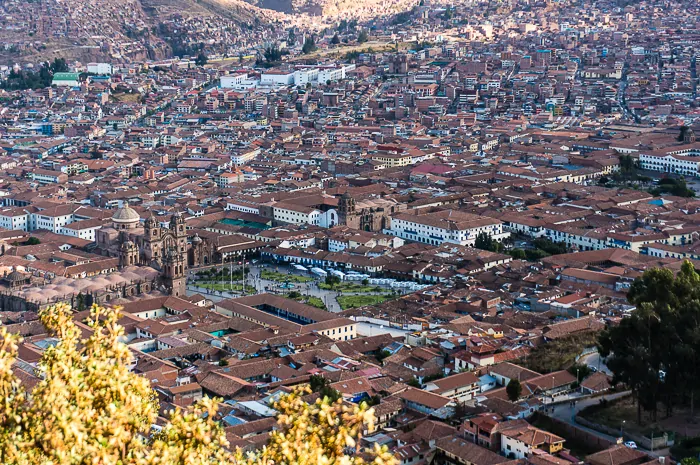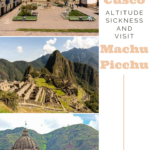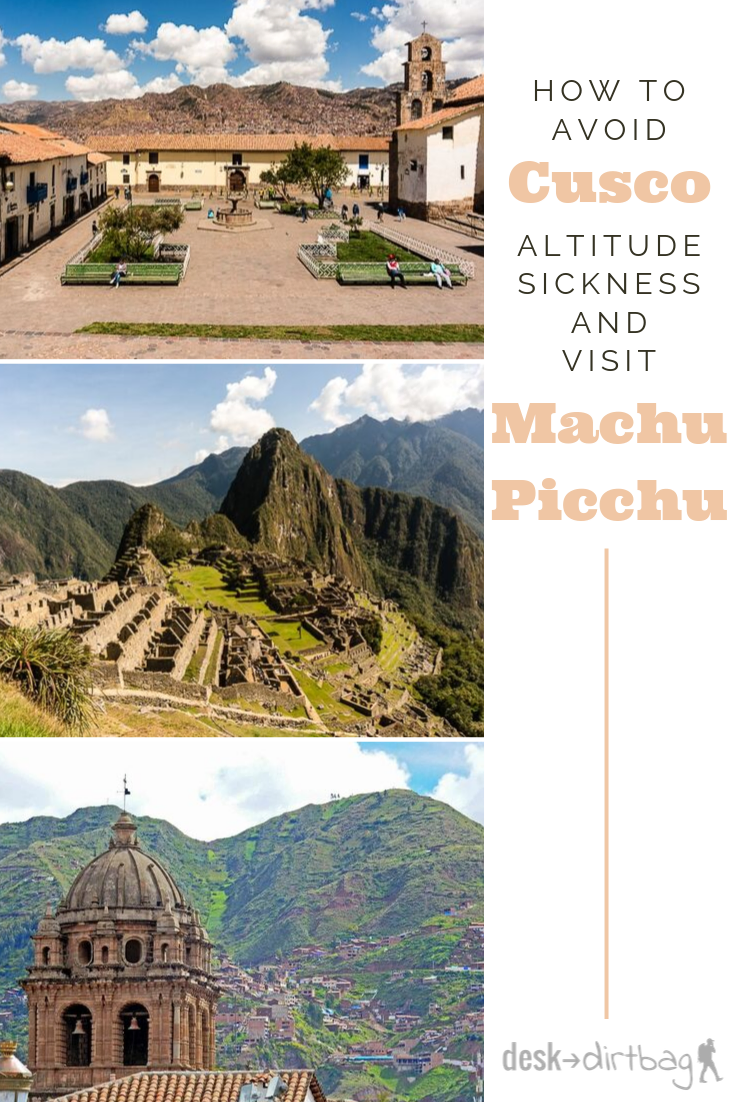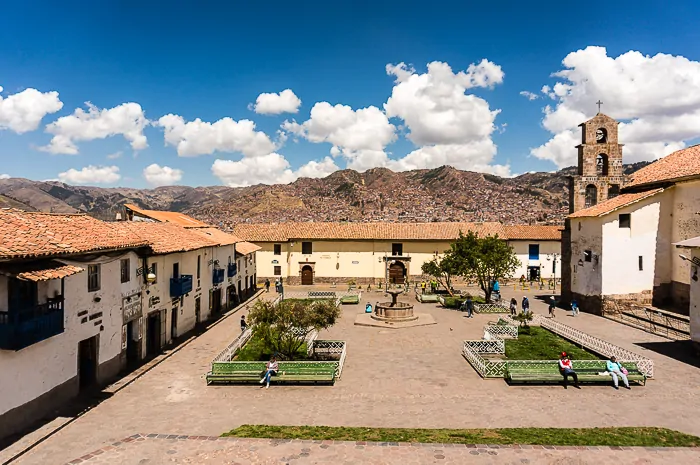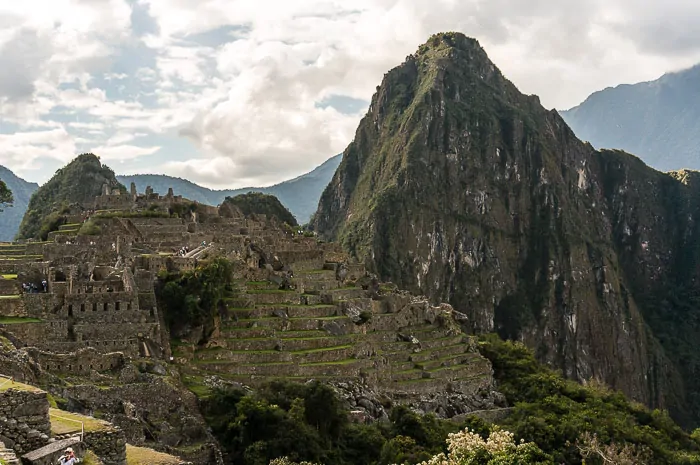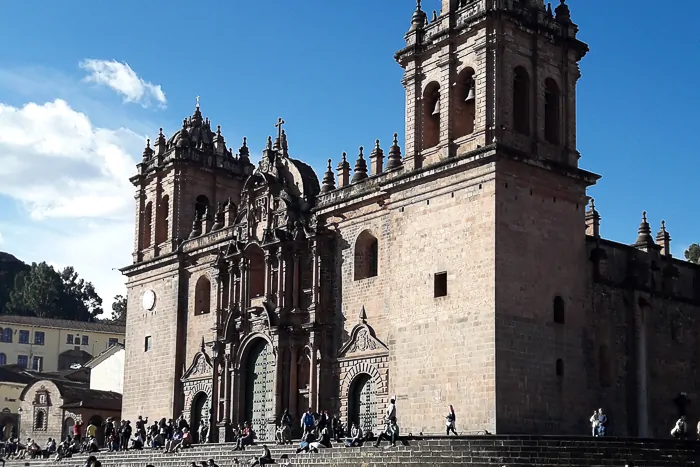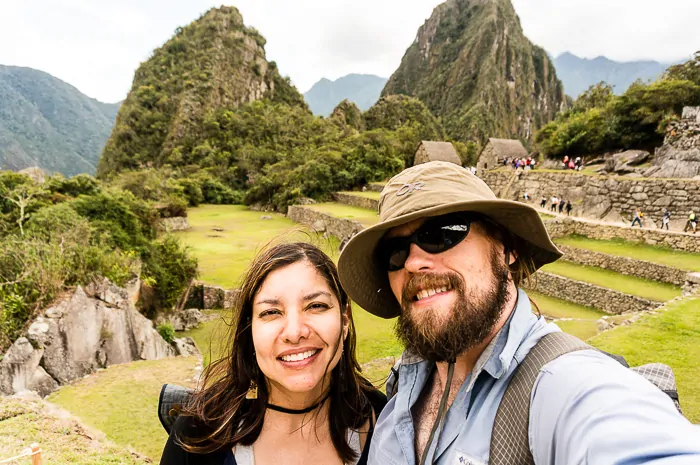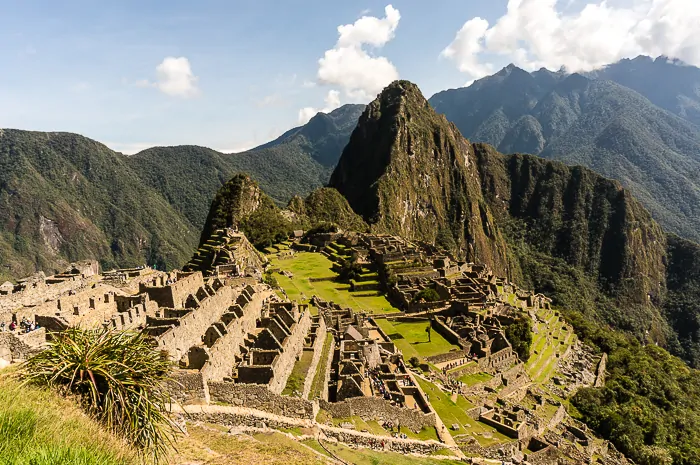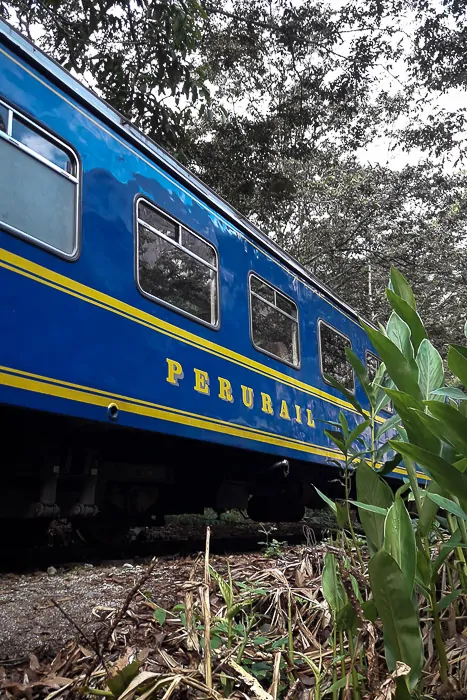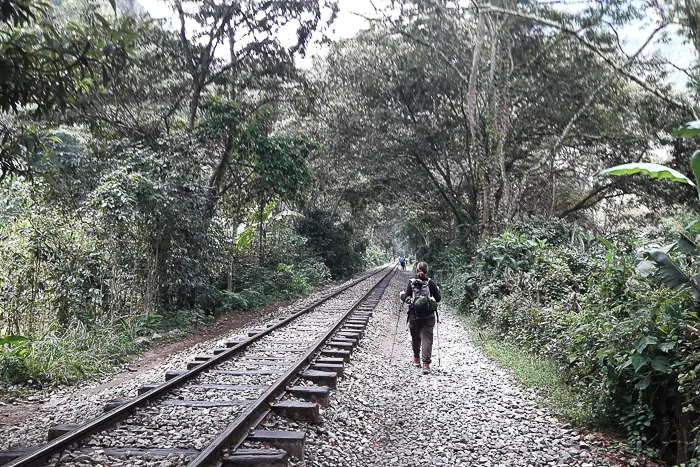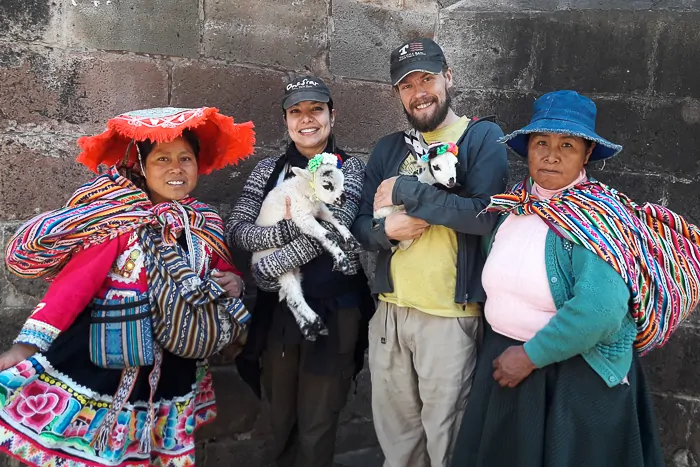More than three million tourists travel to Cusco, Peru annually, the vast majority of whom are on their way to visit the fabled Machu Picchu. While there are no exact numbers or percentages, it is safe to assume that the vast majority feel the effects of altitude and a high number of those go on to develop Cusco altitude sickness.
Traveling to Peru to visit Cusco and Machu Picchu is a once in a lifetime sort of experience for most people, something on their bucket list. It is also quite often a major trip with fairly high costs. So there’s nothing worse than landing at the Cusco airport and going on to develop altitude sickness that hobbles your first few days in the country.
There are steps you can take, however, to reduce the likelihood that you’ll develop altitude sickness in Cusco, or even ways to plan your trip to diminish the possibility.
First, a disclaimer: I’m not a medical professional and not giving medical advice. I am however a mountain climber and have thus learned a lot about acclimatization, high altitude, acute mountain sickness, and other associated factors.
What is the Elevation of Cusco?
Virtually 99% of those of you reading this are living at an altitude below 1,500 meters or 5,000 feet… There are very few cities above that altitude either in North America or Europe (there are some small towns though).
South America is a whole different beast though. There are major metropolises here that sit at extreme altitudes with cities like Bogota, Colombia or La Paz, Bolivia standing out. Cusco has a population of around 500,000 and sits at an altitude of nearly 11,200 feet (3,400 meters).
What is Altitude Sickness?
Due to atmospheric pressure, there is more oxygen in each breath at sea level. As altitude increases, the available amount of oxygen decreases. This means you need to breathe more to receive the same amount of oxygen as you are accustomed to receiving and your heart needs to pump harder to get more oxygen to your brain and muscles, resulting in an increase in blood pressure.
Altitude sickness is not normally experienced except at altitudes above 8,000 feet (Cusco is definitely well beyond that measure) although it can happen at lower altitudes for some people (very rare).
Altitude sickness can happen to anyone and everyone, regardless of your physical conditioning or general health. Even elite athletes or high altitude climbers in the Himalayas can experience altitude sickness. Each individual will respond differently to the challenges presented by altitude.
What Are the Symptoms of Altitude Sickness?
Virtually all who are arriving from living near sea level to Cusco will experience adverse effects from altitude, such as shortness of breath and lethargy. That is normal and to be expected. But NOT everyone who visits will experience Cusco altitude sickness which can be defined as headaches or even vomiting. It is estimated that approximately 50% of people rapidly ascending above 10,000 feet will experience altitude sickness.
It is quite possible that you can fly from Lima to Cusco, use some of our tips below, and be fully acclimatized within a few days.
Altitude sickness symptoms include (in order of severity):
- Shortness of breath
- Loss of appetite
- Fatigue
- Nausea
- Dizziness
- Headaches
- Vomiting
- Pulmonary Edema (Potentially Fatal)
The first few symptoms aren’t really a big deal and could be classified as mild altitude sickness, and are manageable on your trip. But the last few can start to be classified as more severe altitude sickness and can really start to derail your plans and make for an unpleasant trip (or worse).
While the shortness of breath and increased demand on your body will be felt immediately upon landing, you will NOT get sick immediately. That takes from 6 to 24 hours to come on and usually happens on your first night or by the following morning.
If you wake up the next morning and aren’t feeling worse, then you’ve passed the test.
If, however, you’re suffering from Cusco altitude sickness at this point, the only real remedy is to head to lower altitudes so your body can adjust.
Combating Cusco Altitude Sickness
In good news, the body will slowly adjust to altitude over time through a process known as acclimatization. Altitude sickness tends to come on due to rapidly ascending to altitude, such as flying from Lima to Cusco or even taking the bus from Lima to Cusco.
MYTH: It’s a mistake to think that the body will acclimatize during the long 20+ hour bus ride from Lima to Cusco. Unfortunately, that still isn’t enough time for your body to physiologically adjust to such extreme changes if you’re prone to getting altitude sickness.
As a rule of thumb, at altitudes above 8,000 feet, you should only be moving up about 1,000 feet (300 meters) per night in order to avoid altitude sickness.
Mountain climbers use the mantra “climb high, sleep low” meaning that they hike up during the day to higher altitudes but return to a base camp to sleep low. Then the following day they can move up to sleep at their previous high point, and repeat the process. That’s why climbing mountains like Mount Everest take upwards of two months — it’s simply a matter of having sufficient time for the body to acclimatize as it starts to adapt and produce more red blood cells.
You can’t rush this process, and taking a bus doesn’t allow enough time to acclimatize, that is simply a myth. In actuality, I think it probably does more harm than good, because you’re going through windy mountain roads which can make you nauseous, probably aren’t sleeping well, if at all, and probably not drinking enough fluids which can ALL hinder your acclimatization.
In order to reduce the likelihood of suffering from Cusco altitude sickness you should heed the following tips:
- REST! This is one of the most important steps… Ascending too fast and increased physical exertion are two of the biggest causes. You can’t avoid the “ascending too fast” part, but you should take it easy. This means taking a low key day in your hotel. Avoid taking too many stairs or hiking up steep streets.
- DRINK WATER! Dehydration will exacerbate the effects of altitude sickness which is why it is super important that you force yourself to drink water and stay hydrated. Proper hydration is also crucial to blood circulation, which is working overtime at altitude.
- AVOID ALCOHOL! Skip the Cusquena beers and Pisco sours. Alcohol is a diuretic that removes water from the body and is associated with dehydration. This will definitely inhibit your acclimatization process and too much could produce symptoms similar to altitude sickness.
- DRINK COCA TEA? Locals regularly use the coca leaf to ward off the effects of altitude, both chewing the coca leaf and drinking the coca tea. You’ll find coca tea all over Cusco, but I didn’t find it to be beneficial whatsoever. Others swear by the use of coca leaves though.
There are other ways to prevent altitude sickness, including taking pills like Diamox, but that is not the method I would recommend unless you are seriously short on time and aren’t worried about the potential side effects.
Studies have even shown that taking Ginkgo Biloba can help mitigate the effects of altitude and high altitude mountaineer Reinhold Messner used to chomp down whole cloves of garlic to stave off problems. But the best way to acclimatize is simply by giving your body time to adjust, which is what we will talk about next.
Best Way to Acclimatize for Machu Picchu
For those of you coming from sea level, or near sea level, it can be quite tricky coming straight into Cusco and confronting the possibility of altitude sickness. Indeed, this is one of the main things people worry about as they plan their trip to Machu Picchu and start researching how to prevent altitude sickness.
In terms of the best way to acclimatize for Machu Picchu, that largely depends on how you will be visiting these famous Inca ruins.
There are a number of ways to visit Machu Picchu, but the most popular are:
- Hiking the Inca Trail (or an alternative like Salkantay)
- Taking the train to Machu Picchu
- Taking the “back door” via Santa Teresita
The strategy for acclimatization largely depends on the manner in which you will be arriving at Machu Picchu. One important thing to note is that Machu Picchu itself is NOT at a high altitude. Indeed, the ruins are located below 8,000 feet, much lower than Cusco, and below the typical altitude where one suffers from altitude sickness.
Read More: How to Get to Machu Picchu
Hiking the Inca Trail
If you plan to visit Machu Picchu via the Inca Trail, then you will have to hike over a large pass before dropping down to the ruins. This means that altitude is unavoidable.
Your best course of action would be to immediately leave Cusco upon flying in and head to the Sacred Valley, specifically to Ollantaytambo, which sits at 9,160 feet, considerably lower than Cusco. It is a little over two hours from Cusco, and if you leave immediately you avoid prolonged exposure to the altitude of Cusco.
From Ollantaytambo, you could gradually increase your exposure by heading to Pisac (at the other end of the Sacred Valley) for another night or two, before settling into Cusco for a few nights before the scheduled start of your hike.
This slowly increasing exposure to altitude will best position you for a successful Inca Trail hike and avoid the dreaded Cusco altitude sickness.
Taking the Train to Machu Picchu
I’d recommend basically the same strategy as above, head straight to Ollantaytambo, but you can just stay there for a day or two before your train leaves.
The train leaves from Ollantaytambo and will take you to Aguas Calientes (Machu Picchu City) which sits at a lower altitude. Following your visit to the Machu Picchu ruins, you can follow a similar acclimatization pattern above which is to head to Pisac and then end in Cusco, which would mark the highest altitude of your trip.
Taking the Back Door to Machu Picchu
The back door route is the cheapest way to visit Machu Picchu by far and it is also the best way to avoid exposure to extreme altitudes as well.
The back door consists of going by vehicle (there is regular van service from Cusco) to the town of Santa Teresita which sits at 5,085 feet. From here you hike along the train tracks to Aguas Calientes and then visit the ruins.
The tricky thing with this approach would be that you’d need to fly into Cusco early in the morning and hop in a shared van that same day (to avoid prolonged exposure to altitude) to Santa Teresita. The drive itself is about 5.5 hours.
From there you can pass the night in the modest little town of Santa Teresita and then head out the next day to Aguas Calientes. I recommend two nights in Aguas Calientes for this approach (giving you a full day for Machu Picchu and being able to rest), before you head out to the Sacred Valley and then Cusco as described above.
If you have a flight that arrives in Cusco late, you would want to organize a van that leaves first thing in the morning, to limit your exposure to altitude.
Read More: The Cheapest Way to Visit Machu Picchu
The Altitude of Places Near Machu Picchu
Here is a list of all the places we discussed that you may visit during your trip to Machu Picchu (depending on the method you use to get there) including the altitude.
Your goal is to try and immediately head to lower ground and then gradually increase your exposure, spending at least a night or two at each level. Remember, most people are only affected by altitude sickness above 8,000 feet, and you should try to limit your daily overnight changes in elevation to around 1,000 feet (300 meters).
- Santa Teresita – 1,550 meters, 5,085 feet
- Aguas Calientes (Machu Picchu City) – 2,040 meters, 6,692 feet
- Machu Picchu – 2,430 meters, 7,970 feet
- Huayna Picchu – 2,693 meters, 8,835 feet
- Ollantaytambo (Sacred Valley) – 2,792 meters, 9,160 feet
- Pisac (Sacred Valley) – 3,000 meters, 9,800 feet
- Cusco – 3,400 meters, 11,200 feet
- Dead Woman’s Pass on the Inca Trail – 4,215 meters, 13,828 feet
- Apacheta Pass on Salcantay Trek – 4,580 meters, 15,026 feet
Cusco Altitude Sickness
So there you have it, a comprehensive guide to avoiding Cusco altitude sickness and what you should bear in mind when visiting Machu Picchu. Your best bet is to take your time and try not to rush things. People get into trouble because of that and just wanting to check Machu Picchu off the bucket list.
While I didn’t suffer from altitude sickness when visiting Machu Picchu (thanks to our lengthy-time in Peru), but I have suffered from it on other occasions. Let me tell you, it isn’t exactly fun and it will most definitely put a damper on your vacation and travels to Machu Picchu.
If you’re concerned about altitude sickness and spend most of your life near sea level (especially those from the United States or Europe), then you should be a little less aggressive with your schedule if you want to have a more enjoyable trip. Trust me!
Traveling to Cusco, Peru soon? Book your hotels or lodging on Booking.com now to save and check out our guide to the best hostels in Cusco. If you plan to stay longer, I highly recommend looking for a place on Airbnb. And don’t forget to purchase international travel insurance for Peru that will help protect you against illness, injury, and theft. I use and recommend World Nomads for its combination of coverage and affordability.
Read Next: Best Things to Do in Cusco Peru
Share This
Did you enjoy this post about avoiding Cusco altitude sickness? Take a second to share it on Pinterest, Facebook, or Twitter. Thanks!
Latest posts by Desk to Dirtbag (see all)
- 8 Best National Parks to Visit With Your Dog - August 10, 2022
- Where to Stay in Bogota: Ultimate Guide to the Best Neighborhoods, Hostels & Hotels - September 26, 2019
- 10 Best Santiago Tours: Activities to Experience in Chile - September 22, 2019
- Volunteering Abroad: 20+ Ways to Travel the World with a Purpose - September 19, 2019
- How to Avoid Cusco Altitude Sickness When You Visit Machu Picchu - September 15, 2019

